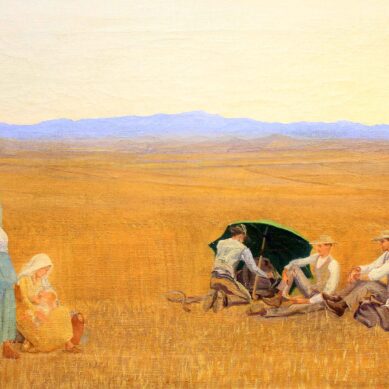You searched
Painter
Cesare Cabras
Are you interested in the sales or the purchase of his artworks?
We buy works of this artist
and of other painters and sculptors from the 16th century to the first half of the 20th century
The Berardi gallery offers a free and without obligation service for evaluation of ancient and modern art . To find your way in the art market, very complex and full of nuances, it is better to rely on a professional consultant who can answer fast and concretely to your needs. The clarity of the answers will resolve effectively the need to estimate or sell an asset.
Contact us immediately without commitment
Answers also in 24 hours:
Cesare Cabras
Cesare Cabras
Cesare Cabras was born in Monserrato, near Cagliari in 1886, into a family of farmers. From an early age, he showed a strong inclination towards painting, and although he was forced by economic necessity to work in the fields, he painted the walls of his house with festoons and garlands. Thus, his work as a farmer, which he continued to do in order to support himself and his family, was accompanied by a passion for art until he was twenty years old, so much so that in 1905 he was able to enter the workshop of the decorator Giuseppe Conci in Cagliari.
The closeness to the “XXV della Campagna Romana”.
Conci encouraged and assisted him in his choice of academic training, so the boy moved to Rome to attend the Academy of Fine Arts. His teachers there were Bruschi, Cambellotti and Bazzani, but he was very interested in the poetics of the “XXV della Campagna Romana”, a group of landscape painters set up in 1904 and still active until the 1930s.
He was attracted by their way of conceiving the landscape, based on a naturalism mediated by poetic sensations and a certain Symbolist sensitivity. So he too began to travel to the Roman countryside to interpret a landscape imbued with mystical values, giving particular importance to peasant work, conceived as a sort of mission. He graduated from the academy in 1912 and his first official paintings, such as The Hermit’s Visit and The Lamentation of Holy Thursday date from this period. In 1913 he joined Pietro Gaudenzi’s studio, but at the same time he approached the Divisionist technique, with which he succeeded in creating landscapes and country scenes characterised by great elegiac power and a careful study of light.
An account in images of a rural and heroic Sardinia: between fields and salt marshes
After the war he continued to frequent Gaudenzi, who was linked to him personally as well as artistically, but returned to Sardinia. He settled in Teulada where he devoted himself tirelessly to the construction of a local rural history through painting. His landscapes and rural scenes, as in his early years, seem to underline the symbolic value of work in the fields, as if it were a sort of heroic epic. Through this conception, he thus adheres to the regime’s propaganda regarding rural work, seen in its strictly mythical and primordial essence. Works such as the series dedicated to the Farmyards, filmed in various places in Sardinia, and The Bride and Groom date from these years. Presented at the Quadriennale in Rome in 1931, this painting reveals Cabras’ profound reflection on popular and rural Sardinian customs, as the bride and groom are in traditional costume.
He took part in the Venice Biennial of 1932 with a group of fourteen paintings, including Rest – Teulada, Pride of work – Monserrato, After fatigue, Glory of the fields, Sweat of the forehead – Siliqua and Fragrances of the earth – Siliqua. Tidal wave and Salt marshes appeared at the Exhibition of the Fascist Union in Florence in 1933, and the painting of the salt pans was the first in a long series dedicated to this theme, which was once again typically Sardinian. In 1934, he stayed in Libya to work on a series of monumental panels depicting scenes of African rural life. On his return to Italy, he continued to paint until the 1960s, always following his poetics of rural narration, seen in a sort of eternal idyll. He died in Monserrato in 1968.
Elena Lago







